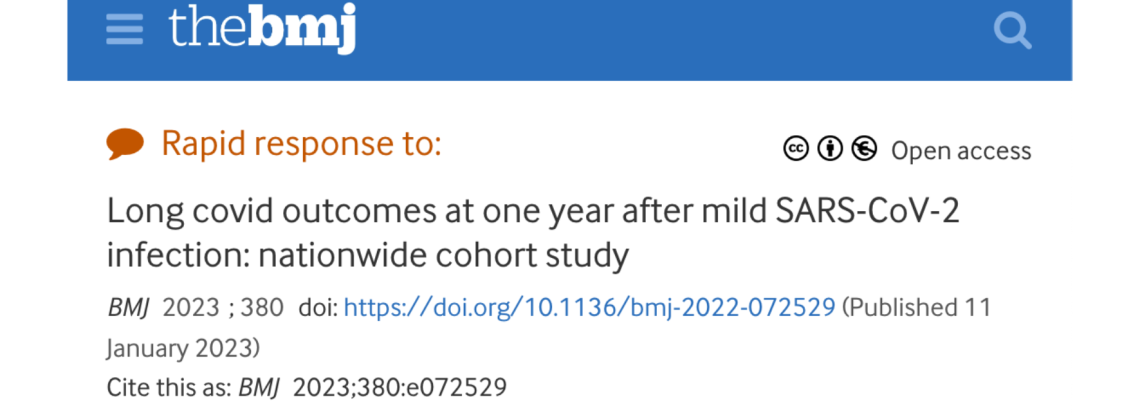On January 18, 2023, Research-Aid Networks and others sent a rapid response to BMJ regarding the study ‘Long covid outcomes at one year after mild SARS-CoV-2 infection: nationwide cohort study’ published on January 11, 2023.
Dear Editor,
The recent article by Mizrahi et al. {1} uses a large electronic health record (EHR) dataset to investigate the risk of different persistent symptoms in the year following SARS-CoV-2 infection. By evaluating symptoms over time and accounting for a range of variables (i.e. age, sex, vaccination status, viral variant) the authors provide valuable data that furthers our understanding of Long Covid disease. However, concerns about the methodology and interpretation mean that the study likely presents an overly optimistic view of Long Covid recovery.
First, the use of EHR events to determine symptom persistence and the inclusion criteria for negative controls (i.e.at least one negative PCR test) could both artificially lower the reported hazard ratios. The authors acknowledge this limitation but it could have a significant impact on the observed persistence of symptoms. EHR events are dependent on patient utilization of the health system and thus a reduction of events at 6+ months of a disease without any proven therapeutic approaches does not necessarily indicate resolution of symptoms. Moreover, the analysis did not assess how many patients were without symptoms at the end of the study period, only whether individual symptoms had lower odds. In addition, the negative PCR test method of determining uninfected status would miss anyone that used an antigen test, anyone with a mild infection that did not test, and anyone that had an asymptomatic infection. The authors also acknowledge that vaccinated patients were not obliged to get tested and therefore breakthrough infections may have been included in the control group. Given the high global SARS-CoV-2 seroprevalence (2), it is likely that a percentage of the ‘uninfected’ population was actually previously infected, which could further lower the hazard ratio.
Second, in analysis of their data the authors conclude that most persistent symptoms return to normal within the first year, that most mild SARS-CoV-2 infections do not lead to “serious or chronic long term morbidity” and that Long Covid disease adds only a small burden on healthcare providers. However, these conclusions are not fully supported by the data. The authors show that despite some symptoms returning to baseline, several still have elevated risks of occuring at 12 months post-infection. In addition, the outcomes that do persist are discussed as non-serious. In comparison to many EHR events (e.g. heart attack or stroke), the persistent symptoms are far less serious; however, this discounts the significant impact of chronic ‘less severe’ symptoms on patient lives and livelihoods, which was not assessed in the study. The authors also do not include any analysis to explore the burden of Long Covid on healthcare providers and thus the conclusion of minimal burden can not be justified from the current data. Finally, there are many ways to involve patients at different stages of EHR studies without jeopardizing data privacy and their inclusion may have helped mitigate some of these interpretation issues.
This is a valuable study that adds to our understanding of Long Covid; however, the authors’ conclusion that “patients with mild covid-19 are at risk for a small number of health outcomes, most of which are resolved within a year from diagnosis” fails to align with self-reported Long Covid symptom persistence (3) and the global lived experience of patients, both of which shows that whilst some symptoms improve, others can persist for longer than one year, with profound impacts on patient health and wellbeing.
References:
1. Mizrahi B, Sudry T, Flaks-Manov N, Yehezkelli Y, Kalkstein N, Akiva P et al. Long covid outcomes at one year after mild SARS-CoV-2 infection: nationwide cohort study BMJ 2023; 380 :e072529 doi:10.1136/bmj-2022-072529.
2. Bergeri I, Whelan MG, Ware H, Subissi L, Nardone A, et al. (2022) Global SARS-CoV-2 seroprevalence from January 2020 to April 2022: A systematic review and meta-analysis of standardized population-based studies. PLOS Medicine 19(11): e1004107 doi: 10.1371/journal.pmed.1004107.
3. Office for National Statistics (ONS), released 5 January 2023, ONS website, statistical bulletin, Prevalence of ongoing symptoms following coronavirus (COVID-19) infection in the UK: 5 January 2023.
Competing interests: JSR is Chair of the Board of Trustees of the UK charity, Long Covid Kids & Friends.


